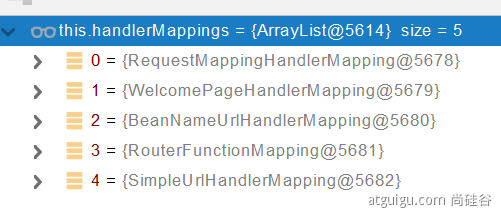web开发
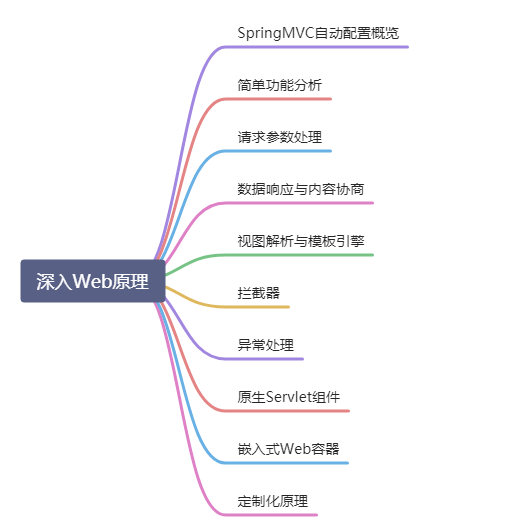
官网地址:https://docs.spring.io/spring-boot/docs/current/reference/html/features.html#features
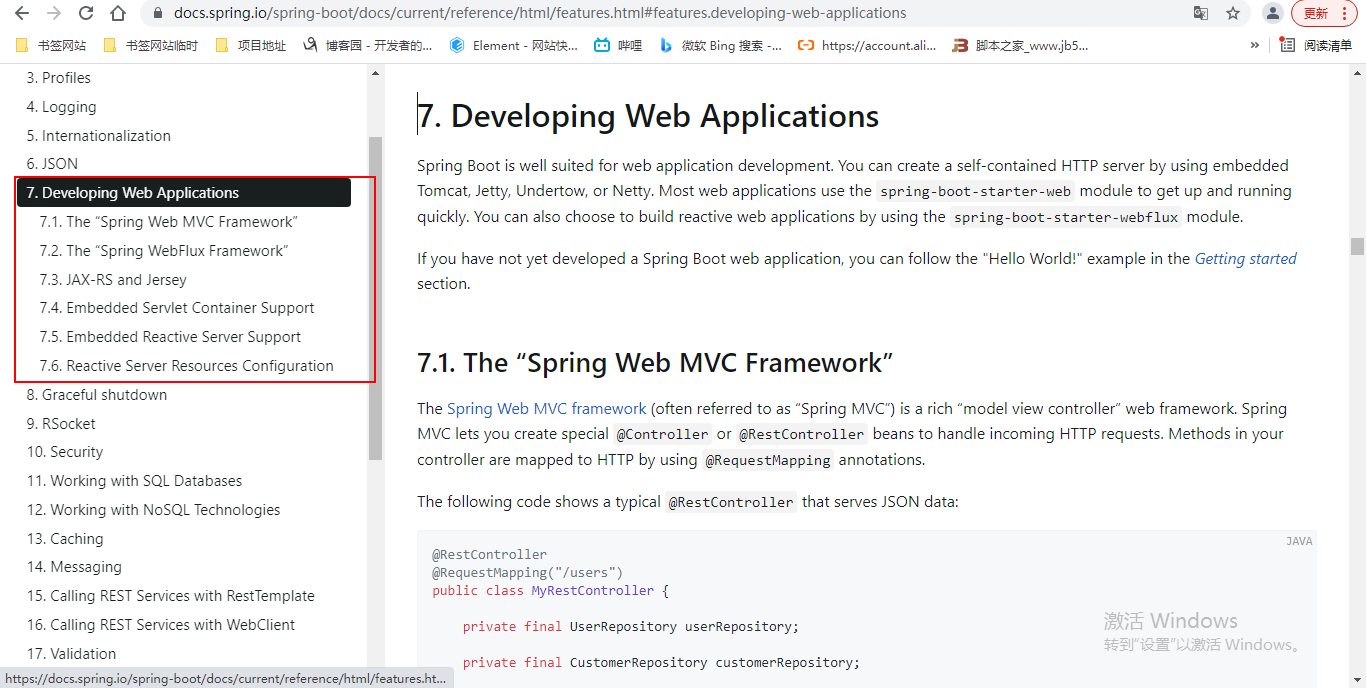
1、SpringMVC自动配置概览
Spring Boot provides auto-configuration for Spring MVC that works well with most applications.(大多场景我们都无需自定义配置)
The auto-configuration adds the following features on top of Spring’s defaults:
- Inclusion of
ContentNegotiatingViewResolverandBeanNameViewResolverbeans.
- 内容协商视图解析器和BeanName视图解析器
- Support for serving static resources, including support for WebJars (covered later in this document)).
- 静态资源(包括webjars)
- Automatic registration of
Converter,GenericConverter, andFormatterbeans.
- 自动注册
Converter,GenericConverter,Formatter
- Support for
HttpMessageConverters(covered later in this document).
- 支持
HttpMessageConverters(后来我们配合内容协商理解原理)
- Automatic registration of
MessageCodesResolver(covered later in this document).
- 自动注册
MessageCodesResolver(国际化用)
- Static
index.htmlsupport.
- 静态index.html 页支持
- Custom
Faviconsupport (covered later in this document).
- 自定义
Favicon
- Automatic use of a
ConfigurableWebBindingInitializerbean (covered later in this document).
- 自动使用
ConfigurableWebBindingInitializer,(DataBinder负责将请求数据绑定到JavaBean上)
If you want to keep those Spring Boot MVC customizations and make more MVC customizations (interceptors, formatters, view controllers, and other features), you can add your own
@Configurationclass of typeWebMvcConfigurerbut without@EnableWebMvc.不用@EnableWebMvc注解。使用
@Configuration+WebMvcConfigurer自定义规则
If you want to provide custom instances of
RequestMappingHandlerMapping,RequestMappingHandlerAdapter, orExceptionHandlerExceptionResolver, and still keep the Spring Boot MVC customizations, you can declare a bean of typeWebMvcRegistrationsand use it to provide custom instances of those components.声明
WebMvcRegistrations改变默认底层组件
If you want to take complete control of Spring MVC, you can add your own
@Configurationannotated with@EnableWebMvc, or alternatively add your own@Configuration-annotatedDelegatingWebMvcConfigurationas described in the Javadoc of@EnableWebMvc.使用
@EnableWebMvc+@Configuration+DelegatingWebMvcConfiguration 全面接管SpringMVC
2、简单功能分析
2.1、静态资源访问
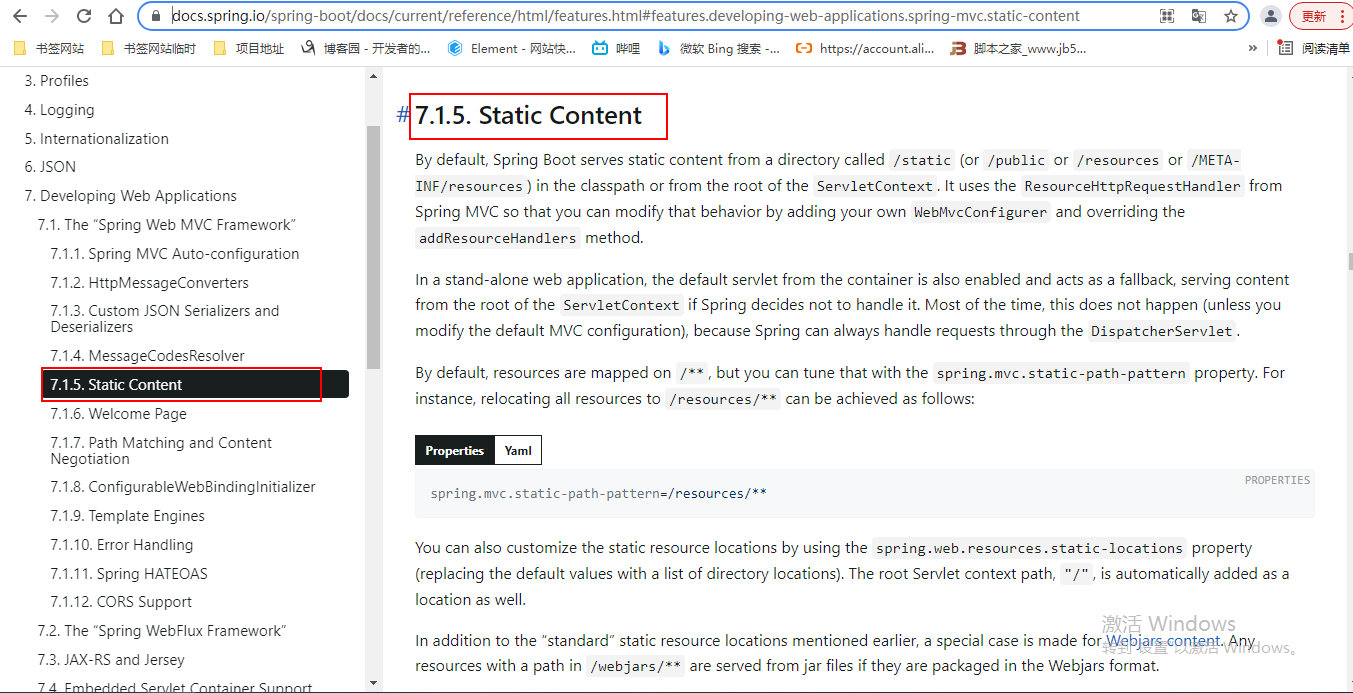
1、静态资源目录
只要静态资源放在类路径下: 类路径下(resources文件夹下) /static (or /public or /resources or /META-INF/resources
访问 : 当前项目根路径/ + 静态资源名 (例子:http://localhost:8080/123.jpg)
原理: 静态映射/**。
类路径下(
resources文件夹下) 当前项目根路径/ +/static(or/publicor/resourcesor/META-INF/resources文件的资源可以正常访问。
请求进来,先去找Controller看能不能处理。不能处理的所有请求又都交给静态资源处理器。静态资源也找不到则响应404页面
案例一,直接访问静态资源
启动项目,类路径下(resources文件夹下) /static (or /public or /resources or /META-INF/resources文件夹下的资源可以正常访问。
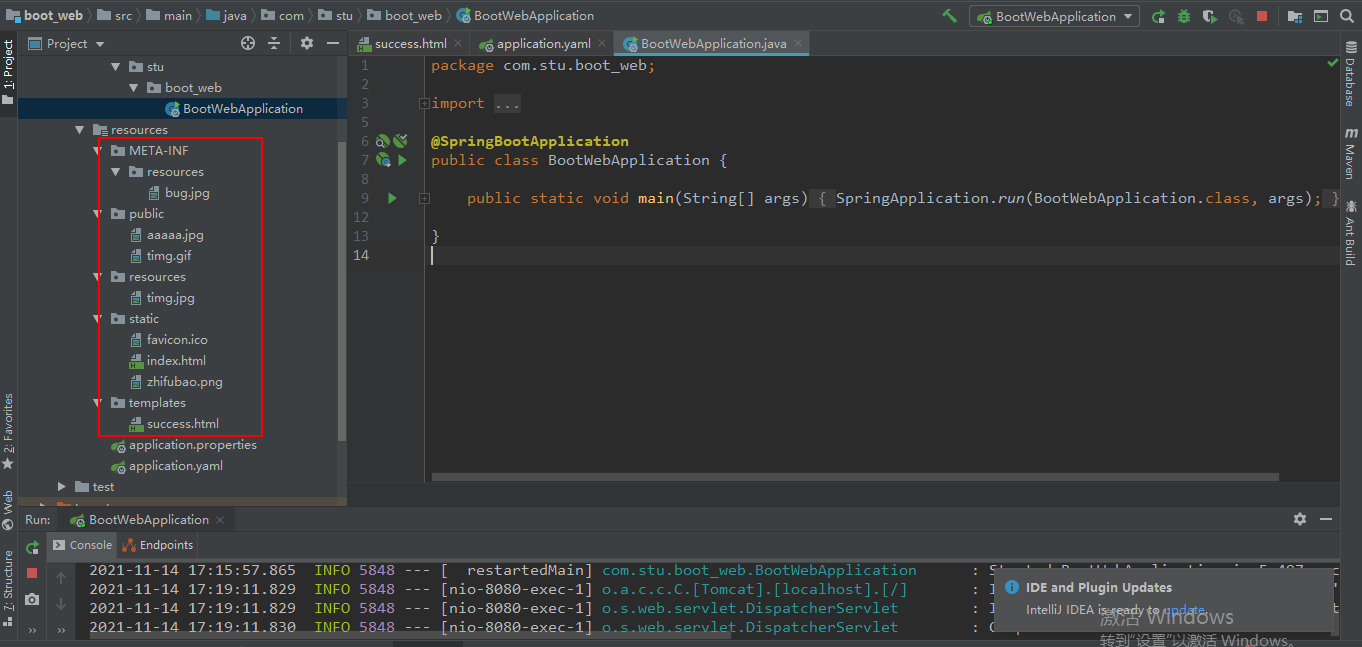
例如访问bug.jpg,其他同样也可以访问。

案例二,编写一个controller,访问路径是/bug.jpg,思考返回的是一个图片还是请求的字符
代码
package com.stu.boot_web.controller; import org.springframework.web.bind.annotation.RequestMapping; import org.springframework.web.bind.annotation.RestController; @RestController public class HelloWord { @RequestMapping("/bug.jpg") public String hello(){ //request return "aaaa"; } /* // @RequestMapping(value = "/user",method = RequestMethod.GET) @GetMapping("/user") public String getUser(){ return "GET-张三"; } // @RequestMapping(value = "/user",method = RequestMethod.POST) @PostMapping("/user") public String saveUser(){ return "POST-张三"; } // @RequestMapping(value = "/user",method = RequestMethod.PUT) @PutMapping("/user") public String putUser(){ return "PUT-张三"; } @DeleteMapping("/user") // @RequestMapping(value = "/user",method = RequestMethod.DELETE) public String deleteUser(){ return "DELETE-张三"; } //扩展点:如何把 _method 这个名字换成我们自己喜欢的 */ }
访问后,返回字符

2、静态资源访问前缀
默认无前缀
spring:
mvc:
static-path-pattern: /test/**
当前项目 + static-path-pattern + 静态资源名 = 静态资源文件夹下找(注意配置完访问路径是根据配置的路径查找,不是根据文件夹的名字找)
配置完访问静态资源的路径,再次启动项目,如果没有test前缀是找不到的。

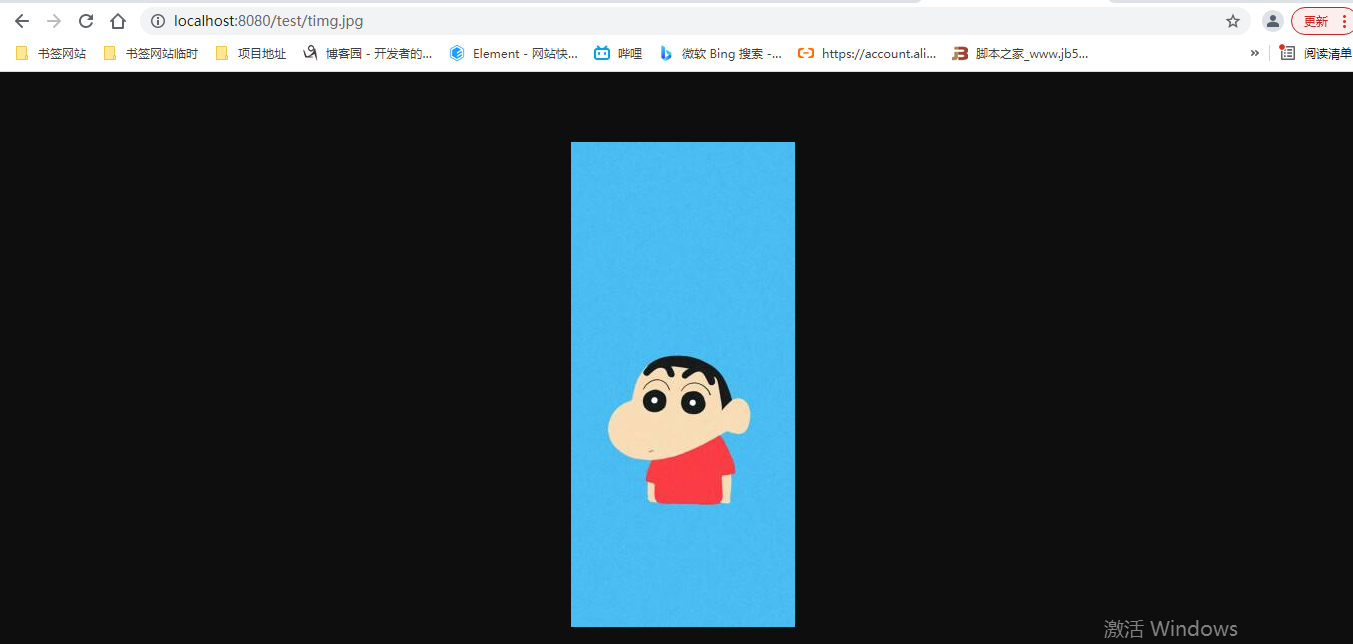
改变默认的静态资源路径
当属性文件配置了static-locations,表示所有默认的静态资源访问,必须访问自定义的web_coustom文件夹里的静态资源,其他文件夹的文件就访问不了了,路径+abc访问静态资源。(注意这里的是指文件夹名称,而不是配置的规则,比如这个配置规则是/web_coustom,表示访问的静态资源必须存放在一个命名为web_coustom的文件夹里,如果没找到这个文件夹会报404错误,即使默认可用的的资源文件夹里有也不行)
注意META-INF/resources文件夹下的静态资源这个没有生效,我依旧可以访问,其他的都生效了,原因我也不清楚,你们可以研究研究。
spring: mvc: static-path-pattern: /abc/** web: resources: static-locations: [classpath:/web_coustom/]
截图
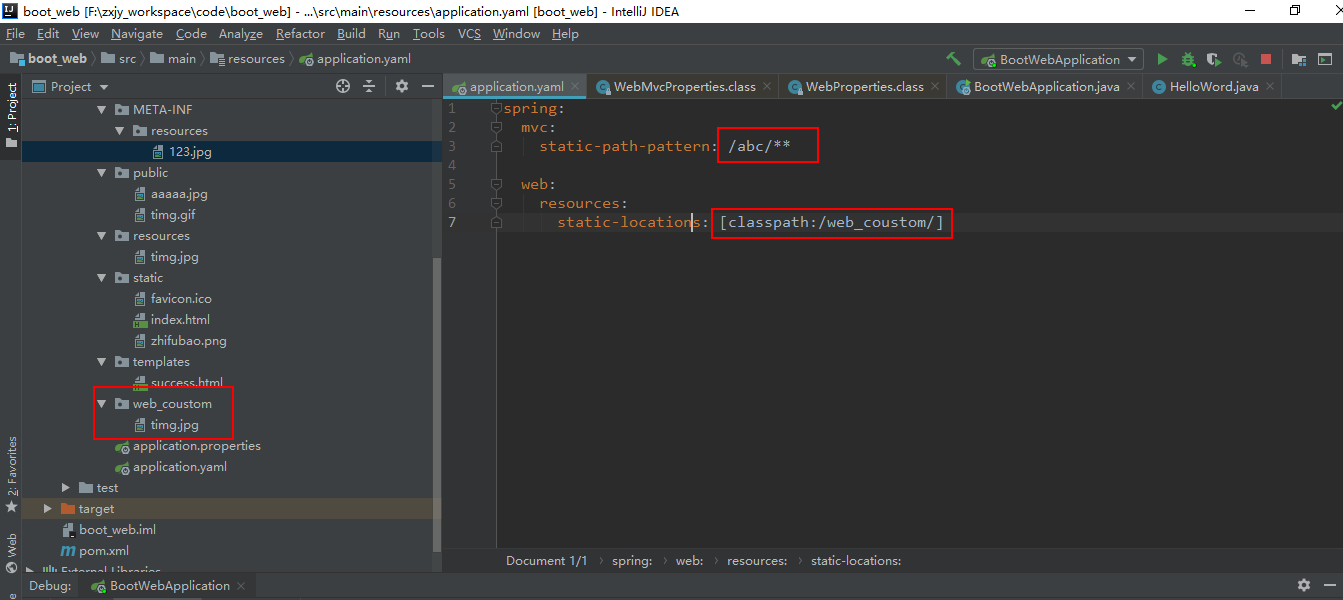
访问自定义的文件夹的图片

访问其他资源

访问META-INF/resources里的资源(这个没生效,原因我也不清楚,其他的都生效了)

3、webjar
自动映射 /webjars/**
<dependency> <groupId>org.webjars</groupId> <artifactId>jquery</artifactId> <version>3.5.1</version> </dependency>
访问地址:http://localhost:8080/webjars/jquery/3.5.1/jquery.js 后面地址要按照依赖里面的包路径
2.2、欢迎页支持
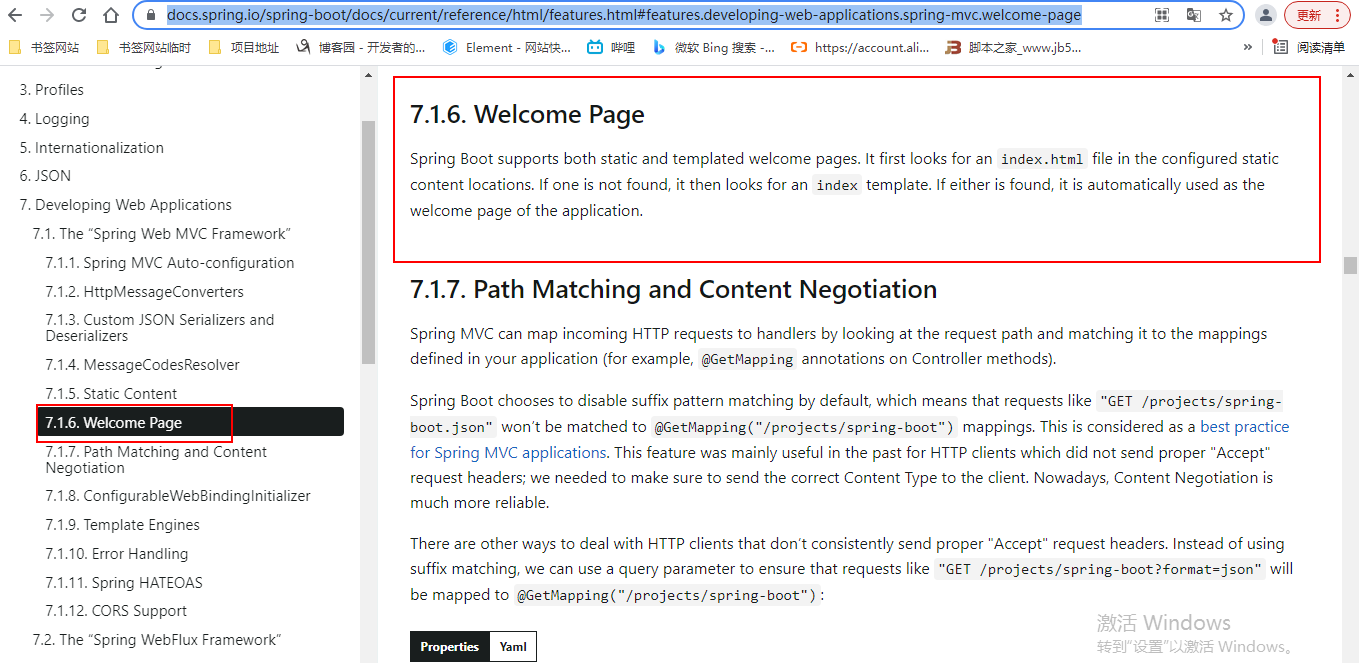
- 静态资源路径下 index.html
- 可以配置静态资源路径
- 但是不可以配置静态资源的访问前缀。否则导致 index.html不能被默认访问(这里的默认访问是指http://localhost:8080/访问方式,项目一启动就会访问的index页面,加上前缀是http://localhost:8080/res/index.html可以访问的,但是不是默认访问的,注意这里不要搞混了)
spring: # mvc: # static-path-pattern: /res/** 这个会导致welcome page功能失效 resources: static-locations: [classpath:/haha/]
目录结构

配置文件有前缀启动项目
spring: mvc: static-path-pattern: /res/** web: resources: static-locations: [classpath:/web_coustom/]

配置文件没有有前缀启动项目(这里给注释掉了)
spring: # mvc: # static-path-pattern: /res/** web: resources: static-locations: [classpath:/web_coustom/]

加上前缀可以访问index页面,但是这个不是默认的欢迎页index

2.3、自定义 Favicon
favicon.ico 放在静态资源目录下即可。
spring: # mvc: # static-path-pattern: /res/** 这个会导致 Favicon 功能失效
如果配置了图片红框里的图标就不生效
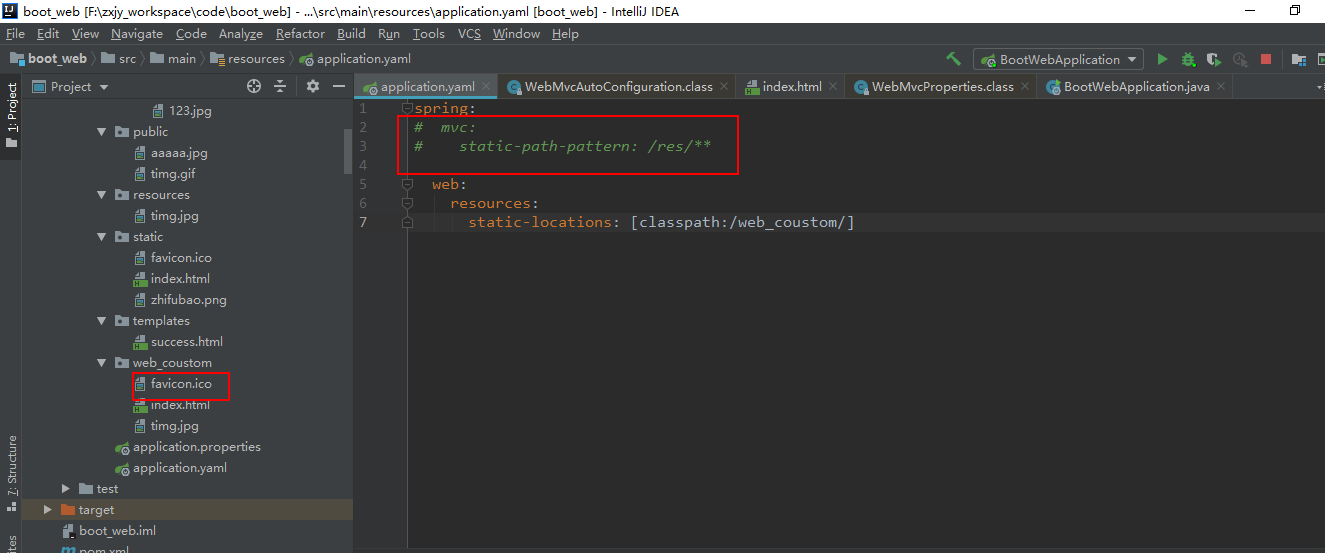

2.4、静态资源配置原理
- SpringBoot启动默认加载 xxxAutoConfiguration 类(自动配置类)
- SpringMVC功能的自动配置类 WebMvcAutoConfiguration,生效
@Configuration(proxyBeanMethods = false) @ConditionalOnWebApplication(type = Type.SERVLET) @ConditionalOnClass({ Servlet.class, DispatcherServlet.class, WebMvcConfigurer.class }) @ConditionalOnMissingBean(WebMvcConfigurationSupport.class) @AutoConfigureOrder(Ordered.HIGHEST_PRECEDENCE + 10) @AutoConfigureAfter({ DispatcherServletAutoConfiguration.class, TaskExecutionAutoConfiguration.class, ValidationAutoConfiguration.class }) public class WebMvcAutoConfiguration {}
- 给容器中配了什么。
@Configuration(proxyBeanMethods = false) @Import(EnableWebMvcConfiguration.class) @EnableConfigurationProperties({ WebMvcProperties.class, ResourceProperties.class }) @Order(0) public static class WebMvcAutoConfigurationAdapter implements WebMvcConfigurer {}
- 配置文件的相关属性和xxx进行了绑定。WebMvcProperties==spring.mvc、ResourceProperties==spring.resources
1、配置类只有一个有参构造器
//有参构造器所有参数的值都会从容器中确定 //ResourceProperties resourceProperties;获取和spring.resources绑定的所有的值的对象 //WebMvcProperties mvcProperties 获取和spring.mvc绑定的所有的值的对象 //ListableBeanFactory beanFactory Spring的beanFactory //HttpMessageConverters 找到所有的HttpMessageConverters //ResourceHandlerRegistrationCustomizer 找到 资源处理器的自定义器。========= //DispatcherServletPath //ServletRegistrationBean 给应用注册Servlet、Filter.... public WebMvcAutoConfigurationAdapter(ResourceProperties resourceProperties, WebMvcProperties mvcProperties, ListableBeanFactory beanFactory, ObjectProvider<HttpMessageConverters> messageConvertersProvider, ObjectProvider<ResourceHandlerRegistrationCustomizer> resourceHandlerRegistrationCustomizerProvider, ObjectProvider<DispatcherServletPath> dispatcherServletPath, ObjectProvider<ServletRegistrationBean<?>> servletRegistrations) { this.resourceProperties = resourceProperties; this.mvcProperties = mvcProperties; this.beanFactory = beanFactory; this.messageConvertersProvider = messageConvertersProvider; this.resourceHandlerRegistrationCustomizer = resourceHandlerRegistrationCustomizerProvider.getIfAvailable(); this.dispatcherServletPath = dispatcherServletPath; this.servletRegistrations = servletRegistrations; }
2、资源处理的默认规则
@Override public void addResourceHandlers(ResourceHandlerRegistry registry) { if (!this.resourceProperties.isAddMappings()) { logger.debug("Default resource handling disabled"); return; } Duration cachePeriod = this.resourceProperties.getCache().getPeriod(); CacheControl cacheControl = this.resourceProperties.getCache().getCachecontrol().toHttpCacheControl(); //webjars的规则 if (!registry.hasMappingForPattern("/webjars/**")) { customizeResourceHandlerRegistration(registry.addResourceHandler("/webjars/**") .addResourceLocations("classpath:/META-INF/resources/webjars/") .setCachePeriod(getSeconds(cachePeriod)).setCacheControl(cacheControl)); } // String staticPathPattern = this.mvcProperties.getStaticPathPattern(); if (!registry.hasMappingForPattern(staticPathPattern)) { customizeResourceHandlerRegistration(registry.addResourceHandler(staticPathPattern) .addResourceLocations(getResourceLocations(this.resourceProperties.getStaticLocations())) .setCachePeriod(getSeconds(cachePeriod)).setCacheControl(cacheControl)); } }
spring: # mvc: # static-path-pattern: /res/** resources: add-mappings: false 禁用所有静态资源规则
@ConfigurationProperties(prefix = "spring.resources", ignoreUnknownFields = false) public class ResourceProperties { private static final String[] CLASSPATH_RESOURCE_LOCATIONS = { "classpath:/META-INF/resources/", "classpath:/resources/", "classpath:/static/", "classpath:/public/" }; /** * Locations of static resources. Defaults to classpath:[/META-INF/resources/, * /resources/, /static/, /public/]. */ private String[] staticLocations = CLASSPATH_RESOURCE_LOCATIONS;
3、欢迎页的处理规则
HandlerMapping:处理器映射。保存了每一个Handler能处理哪些请求。 @Bean public WelcomePageHandlerMapping welcomePageHandlerMapping(ApplicationContext applicationContext, FormattingConversionService mvcConversionService, ResourceUrlProvider mvcResourceUrlProvider) { WelcomePageHandlerMapping welcomePageHandlerMapping = new WelcomePageHandlerMapping( new TemplateAvailabilityProviders(applicationContext), applicationContext, getWelcomePage(), this.mvcProperties.getStaticPathPattern()); welcomePageHandlerMapping.setInterceptors(getInterceptors(mvcConversionService, mvcResourceUrlProvider)); welcomePageHandlerMapping.setCorsConfigurations(getCorsConfigurations()); return welcomePageHandlerMapping; } WelcomePageHandlerMapping(TemplateAvailabilityProviders templateAvailabilityProviders, ApplicationContext applicationContext, Optional<Resource> welcomePage, String staticPathPattern) { if (welcomePage.isPresent() && "/**".equals(staticPathPattern)) { //要用欢迎页功能,必须是/** logger.info("Adding welcome page: " + welcomePage.get()); setRootViewName("forward:index.html"); } else if (welcomeTemplateExists(templateAvailabilityProviders, applicationContext)) { // 调用Controller /index logger.info("Adding welcome page template: index"); setRootViewName("index"); } }
3、请求参数处理
0、请求映射
1、rest使用与原理
- @xxxMapping;
- Rest风格支持(使用HTTP请求方式动词来表示对资源的操作)
- 以前:/getUser 获取用户 /deleteUser 删除用户 /editUser 修改用户 /saveUser 保存用户
- 现在: /user GET-获取用户 DELETE-删除用户 PUT-修改用户 POST-保存用户
- 核心Filter;HiddenHttpMethodFilter
- 用法: 表单method=post,隐藏域 _method=put
- SpringBoot中手动开启
- 扩展:如何把_method 这个名字换成我们自己喜欢的。
@RequestMapping(value = "/user",method = RequestMethod.GET) public String getUser(){ return "GET-张三"; } @RequestMapping(value = "/user",method = RequestMethod.POST) public String saveUser(){ return "POST-张三"; } @RequestMapping(value = "/user",method = RequestMethod.PUT) public String putUser(){ return "PUT-张三"; } @RequestMapping(value = "/user",method = RequestMethod.DELETE) public String deleteUser(){ return "DELETE-张三"; } @Bean @ConditionalOnMissingBean(HiddenHttpMethodFilter.class) @ConditionalOnProperty(prefix = "spring.mvc.hiddenmethod.filter", name = "enabled", matchIfMissing = false) public OrderedHiddenHttpMethodFilter hiddenHttpMethodFilter() { return new OrderedHiddenHttpMethodFilter(); } //自定义filter @Bean public HiddenHttpMethodFilter hiddenHttpMethodFilter(){ HiddenHttpMethodFilter methodFilter = new HiddenHttpMethodFilter(); methodFilter.setMethodParam("_m"); return methodFilter; }
Rest原理(表单提交要使用REST的时候)
- 表单提交会带上_method=PUT
- 请求过来被HiddenHttpMethodFilter拦截
- 请求是否正常,并且是POST
- 获取到_method的值。
- 兼容以下请求;PUT.DELETE.PATCH
- 原生request(post),包装模式requesWrapper重写了getMethod方法,返回的是传入的值。
- 过滤器链放行的时候用wrapper。以后的方法调用getMethod是调用requesWrapper的。
源码查找
WebMvcAutoConfiguration类里OrderedHiddenHttpMethodFilter方法-》OrderedHiddenHttpMethodFilter类找到HiddenHttpMethodFilter类
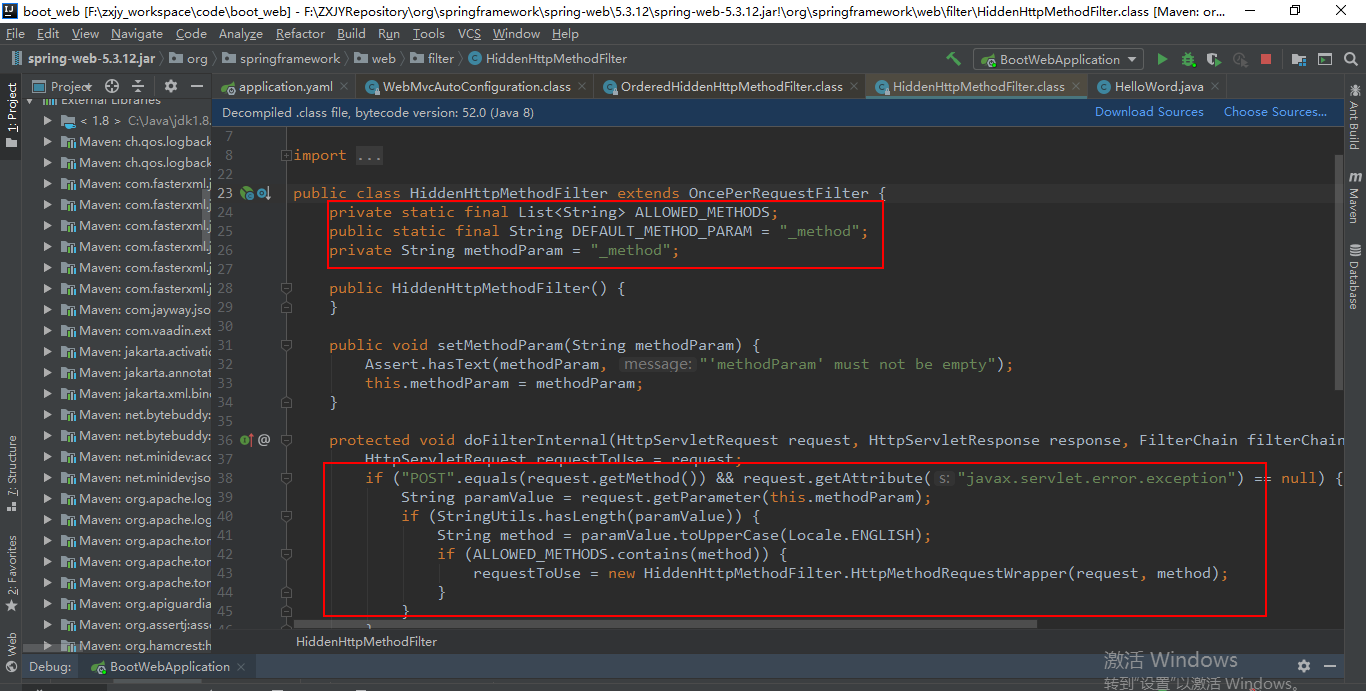
Rest使用客户端工具
●如PostMan直接发送Put、delete等方式请求,无需Filter。
spring: mvc: hiddenmethod: filter: enabled: true #开启页面表单的Rest功能
2、请求映射原理
springboot所有请求底层使用DispatcherServlet类。
FrameworkServlet会重写doGet和doPost。

SpringMVC功能分析都从 org.springframework.web.servlet.DispatcherServlet-》doDispatch()
protected void doDispatch(HttpServletRequest request, HttpServletResponse response) throws Exception { HttpServletRequest processedRequest = request; HandlerExecutionChain mappedHandler = null; boolean multipartRequestParsed = false; WebAsyncManager asyncManager = WebAsyncUtils.getAsyncManager(request); try { ModelAndView mv = null; Exception dispatchException = null; try { processedRequest = checkMultipart(request); multipartRequestParsed = (processedRequest != request); // 找到当前请求使用哪个Handler(Controller的方法)处理 mappedHandler = getHandler(processedRequest); //HandlerMapping:处理器映射。/xxx->>xxxx
五个HandlerMapper
RequestMappingHandlerMapping:保存了所有@RequestMapping 和handler的映射规则。
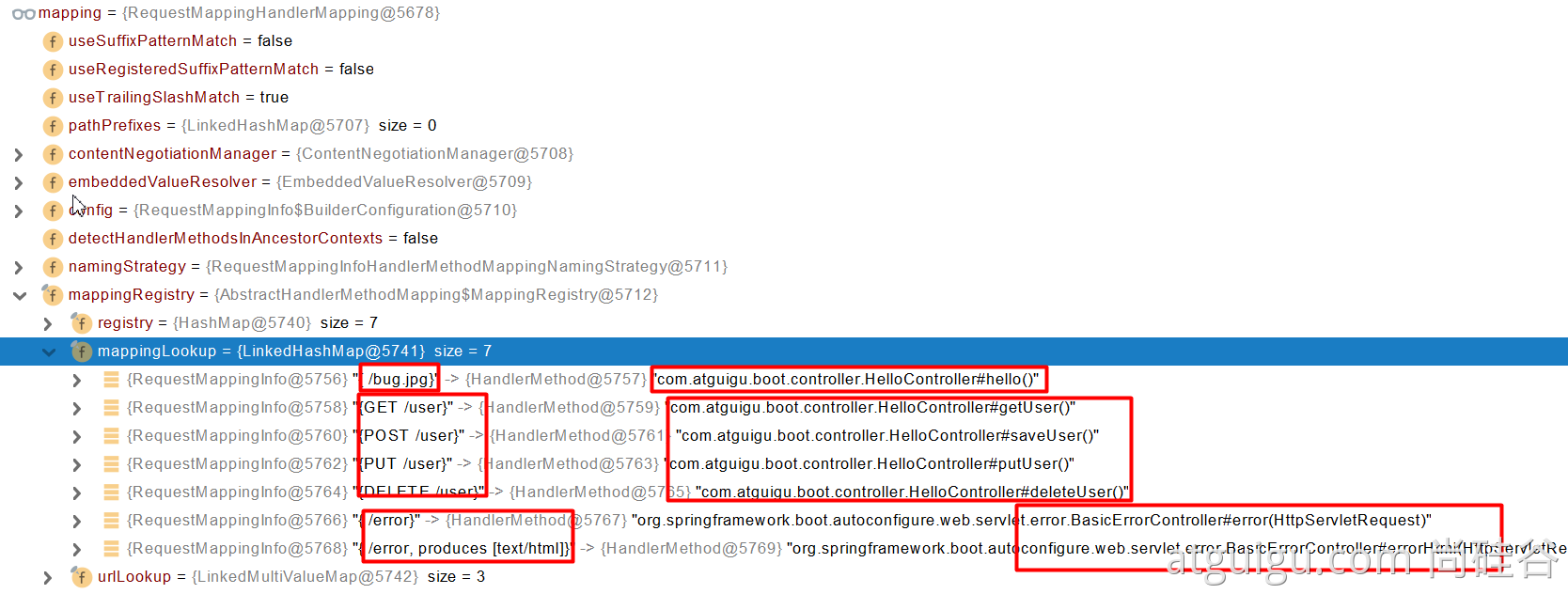
所有的请求映射都在HandlerMapping中。
- SpringBoot自动配置欢迎页的 WelcomePageHandlerMapping 。访问 /能访问到index.html;
- SpringBoot自动配置了默认 的 RequestMappingHandlerMapping
- 请求进来,挨个尝试所有的HandlerMapping看是否有请求信息。
- 如果有就找到这个请求对应的handler
- 如果没有就是下一个 HandlerMapping
- 我们需要一些自定义的映射处理,我们也可以自己给容器中放HandlerMapping。自定义 HandlerMapping
protected HandlerExecutionChain getHandler(HttpServletRequest request) throws Exception { if (this.handlerMappings != null) { for (HandlerMapping mapping : this.handlerMappings) { HandlerExecutionChain handler = mapping.getHandler(request); if (handler != null) { return handler; } } } return null; }
1、普通参数与基本注解
1.1、注解:
@PathVariable、@RequestHeader、@ModelAttribute、@RequestParam、@MatrixVariable、@CookieValue、@RequestBody
<!DOCTYPE html> <html lang="en"> <head> <meta charset="UTF-8"> <title>Title</title> </head> <body> <h1>atguigu,欢迎您</h1> 测试REST风格; <form action="/user" method="get"> <input value="REST-GET 提交" type="submit"/> </form> <form action="/user" method="post"> <input value="REST-POST 提交" type="submit"/> </form> <form action="/user" method="post"> <input name="_method" type="hidden" value="delete"/> <input name="_m" type="hidden" value="delete"/> <input value="REST-DELETE 提交" type="submit"/> </form> <form action="/user" method="post"> <input name="_method" type="hidden" value="PUT"/> <input value="REST-PUT 提交" type="submit"/> </form> <hr/> 测试基本注解: <ul> <a href="car/3/owner/lisi?age=18&inters=basketball&inters=game">car/{id}/owner/{username}</a> <li>@PathVariable(路径变量)</li> <li>@RequestHeader(获取请求头)</li> <li>@RequestParam(获取请求参数)</li> <li>@CookieValue(获取cookie值)</li> <li>@RequestBody(获取请求体[POST])</li> <li>@RequestAttribute(获取request域属性)</li> <li>@MatrixVariable(矩阵变量)</li> </ul> /cars/{path}?xxx=xxx&aaa=ccc queryString 查询字符串。@RequestParam;<br/> /cars/sell;low=34;brand=byd,audi,yd ;矩阵变量 <br/> 页面开发,cookie禁用了,session里面的内容怎么使用; session.set(a,b)---> jsessionid ---> cookie ----> 每次发请求携带。 url重写:/abc;jsesssionid=xxxx 把cookie的值使用矩阵变量的方式进行传递. /boss/1/2 /boss/1;age=20/2;age=20 <a href="/cars/sell;low=34;brand=byd,audi,yd">@MatrixVariable(矩阵变量)</a> <a href="/cars/sell;low=34;brand=byd;brand=audi;brand=yd">@MatrixVariable(矩阵变量)</a> <a href="/boss/1;age=20/2;age=10">@MatrixVariable(矩阵变量)/boss/{bossId}/{empId}</a> <br/> <form action="/save" method="post"> 测试@RequestBody获取数据 <br/> 用户名:<input name="userName"/> <br> 邮箱:<input name="email"/> <input type="submit" value="提交"/> </form> <ol> <li>矩阵变量需要在SpringBoot中手动开启</li> <li>根据RFC3986的规范,矩阵变量应当绑定在路径变量中!</li> <li>若是有多个矩阵变量,应当使用英文符号;进行分隔。</li> <li>若是一个矩阵变量有多个值,应当使用英文符号,进行分隔,或之命名多个重复的key即可。</li> <li>如:/cars/sell;low=34;brand=byd,audi,yd</li> </ol> <hr/> 测试原生API: <a href="/testapi">测试原生API</a> <hr/> 测试复杂类型:<hr/> 测试封装POJO; <form action="/saveuser" method="post"> 姓名: <input name="userName" value="zhangsan"/> <br/> 年龄: <input name="age" value="18"/> <br/> 生日: <input name="birth" value="2019/12/10"/> <br/> <!-- 宠物姓名:<input name="pet.name" value="阿猫"/><br/>--> <!-- 宠物年龄:<input name="pet.age" value="5"/>--> 宠物: <input name="pet" value="啊猫,3"/> <input type="submit" value="保存"/> </form> <br> </body> </html>
controller
@RestController public class ParameterTestController { // car/2/owner/zhangsan @GetMapping("/car/{id}/owner/{username}") public Map<String,Object> getCar(@PathVariable("id") Integer id, @PathVariable("username") String name, @PathVariable Map<String,String> pv, @RequestHeader("User-Agent") String userAgent, @RequestHeader Map<String,String> header, @RequestParam("age") Integer age, @RequestParam("inters") List<String> inters, @RequestParam Map<String,String> params, @CookieValue("_ga") String _ga, @CookieValue("_ga") Cookie cookie){ Map<String,Object> map = new HashMap<>(); // map.put("id",id); // map.put("name",name); // map.put("pv",pv); // map.put("userAgent",userAgent); // map.put("headers",header); map.put("age",age); map.put("inters",inters); map.put("params",params); map.put("_ga",_ga); System.out.println(cookie.getName()+"===>"+cookie.getValue()); return map; } @PostMapping("/save") public Map postMethod(@RequestBody String content){ Map<String,Object> map = new HashMap<>(); map.put("content",content); return map; } //1、语法: 请求路径:/cars/sell;low=34;brand=byd,audi,yd //2、SpringBoot默认是禁用了矩阵变量的功能 // 手动开启:原理。对于路径的处理。UrlPathHelper进行解析。 // removeSemicolonContent(移除分号内容)支持矩阵变量的 //3、矩阵变量必须有url路径变量才能被解析 @GetMapping("/cars/{path}") public Map carsSell(@MatrixVariable("low") Integer low, @MatrixVariable("brand") List<String> brand, @PathVariable("path") String path){ Map<String,Object> map = new HashMap<>(); map.put("low",low); map.put("brand",brand); map.put("path",path); return map; } // /boss/1;age=20/2;age=10 @GetMapping("/boss/{bossId}/{empId}") public Map boss(@MatrixVariable(value = "age",pathVar = "bossId") Integer bossAge, @MatrixVariable(value = "age",pathVar = "empId") Integer empAge){ Map<String,Object> map = new HashMap<>(); map.put("bossAge",bossAge); map.put("empAge",empAge); return map; } }
1.2、Servlet API:
WebRequest、ServletRequest、MultipartRequest、 HttpSession、javax.servlet.http.PushBuilder、Principal、InputStream、Reader、HttpMethod、Locale、TimeZone、ZoneId
ServletRequestMethodArgumentResolver 以上的部分参数
@Override public boolean supportsParameter(MethodParameter parameter) { Class<?> paramType = parameter.getParameterType(); return (WebRequest.class.isAssignableFrom(paramType) || ServletRequest.class.isAssignableFrom(paramType) || MultipartRequest.class.isAssignableFrom(paramType) || HttpSession.class.isAssignableFrom(paramType) || (pushBuilder != null && pushBuilder.isAssignableFrom(paramType)) || Principal.class.isAssignableFrom(paramType) || InputStream.class.isAssignableFrom(paramType) || Reader.class.isAssignableFrom(paramType) || HttpMethod.class == paramType || Locale.class == paramType || TimeZone.class == paramType || ZoneId.class == paramType); }
1.3、复杂参数:
Map、Model(map、model里面的数据会被放在request的请求域 request.setAttribute)、Errors/BindingResult、RedirectAttributes( 重定向携带数据)、ServletResponse(response)、SessionStatus、UriComponentsBuilder、ServletUriComponentsBuilder
Map<String,Object> map, Model model, HttpServletRequest request 都是可以给request域中放数据,
request.getAttribute();
Map、Model类型的参数,会返回 mavContainer.getModel();---> BindingAwareModelMap 是Model 也是Map
mavContainer.getModel(); 获取到值的


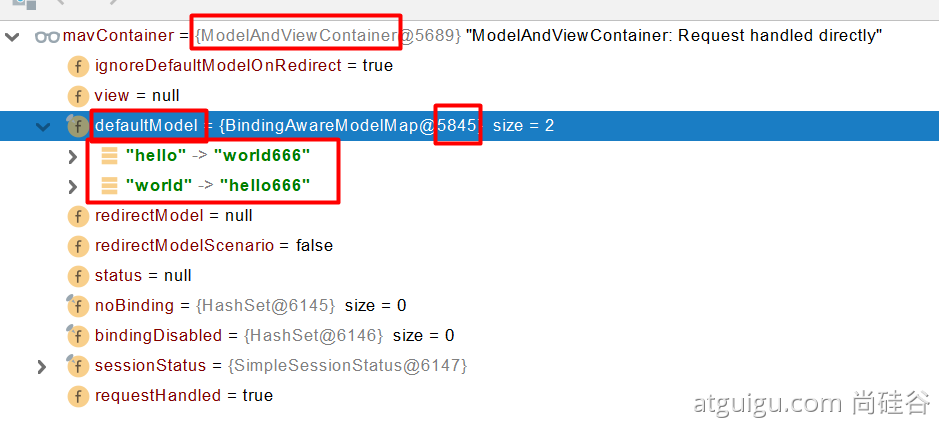
1.4、自定义对象参数:
可以自动类型转换与格式化,可以级联封装。
/** * 姓名: <input name="userName"/> <br/> * 年龄: <input name="age"/> <br/> * 生日: <input name="birth"/> <br/> * 宠物姓名:<input name="pet.name"/><br/> * 宠物年龄:<input name="pet.age"/> */ @Data public class Person { private String userName; private Integer age; private Date birth; private Pet pet; } @Data public class Pet { private String name; private String age; } result
2、POJO封装过程
- ServletModelAttributeMethodProcessor
3、参数处理原理
- HandlerMapping中找到能处理请求的Handler(Controller.method())
- 为当前Handler 找一个适配器 HandlerAdapter; RequestMappingHandlerAdapter
- 适配器执行目标方法并确定方法参数的每一个值
1、HandlerAdapter

0 - 支持方法上标注@RequestMapping
1 - 支持函数式编程的
xxxxxx
2、执行目标方法
// Actually invoke the handler. //DispatcherServlet -- doDispatch mv = ha.handle(processedRequest, response, mappedHandler.getHandler());
mav = invokeHandlerMethod(request, response, handlerMethod); //执行目标方法 //ServletInvocableHandlerMethod Object returnValue = invokeForRequest(webRequest, mavContainer, providedArgs); //获取方法的参数值 Object[] args = getMethodArgumentValues(request, mavContainer, providedArgs);


- 当前解析器是否支持解析这种参数
- 支持就调用 resolveArgument
4、返回值处理器
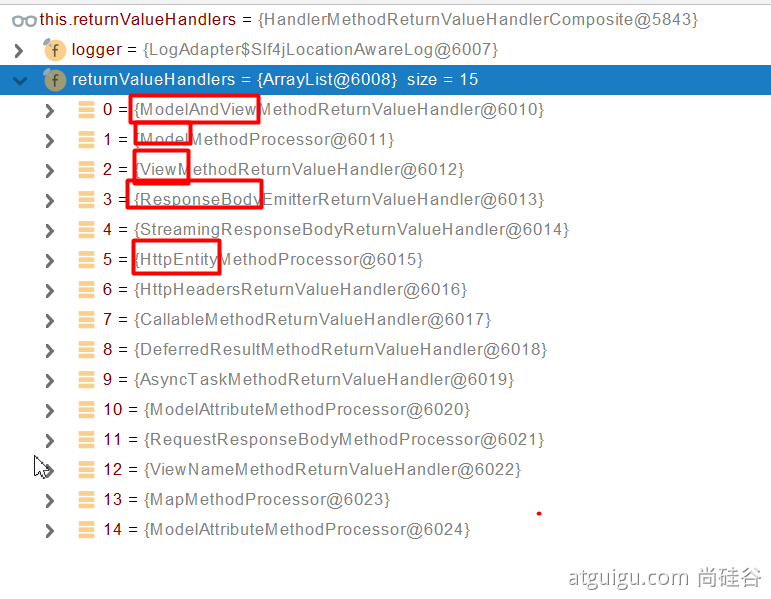
5、如何确定目标方法每一个参数的值
============InvocableHandlerMethod========================== protected Object[] getMethodArgumentValues(NativeWebRequest request, @Nullable ModelAndViewContainer mavContainer, Object... providedArgs) throws Exception { MethodParameter[] parameters = getMethodParameters(); if (ObjectUtils.isEmpty(parameters)) { return EMPTY_ARGS; } Object[] args = new Object[parameters.length]; for (int i = 0; i < parameters.length; i++) { MethodParameter parameter = parameters[i]; parameter.initParameterNameDiscovery(this.parameterNameDiscoverer); args[i] = findProvidedArgument(parameter, providedArgs); if (args[i] != null) { continue; } if (!this.resolvers.supportsParameter(parameter)) { throw new IllegalStateException(formatArgumentError(parameter, "No suitable resolver")); } try { args[i] = this.resolvers.resolveArgument(parameter, mavContainer, request, this.dataBinderFactory); } catch (Exception ex) { // Leave stack trace for later, exception may actually be resolved and handled... if (logger.isDebugEnabled()) { String exMsg = ex.getMessage(); if (exMsg != null && !exMsg.contains(parameter.getExecutable().toGenericString())) { logger.debug(formatArgumentError(parameter, exMsg)); } } throw ex; } } return args; }
5.1、挨个判断所有参数解析器那个支持解析这个参数
@Nullable private HandlerMethodArgumentResolver getArgumentResolver(MethodParameter parameter) { HandlerMethodArgumentResolver result = this.argumentResolverCache.get(parameter); if (result == null) { for (HandlerMethodArgumentResolver resolver : this.argumentResolvers) { if (resolver.supportsParameter(parameter)) { result = resolver; this.argumentResolverCache.put(parameter, result); break; } } } return result; }
5.2、解析这个参数的值
调用各自 HandlerMethodArgumentResolver 的 resolveArgument 方法即可
5.3、自定义类型参数 封装POJO
ServletModelAttributeMethodProcessor 这个参数处理器支持是否为简单类型。
public static boolean isSimpleValueType(Class<?> type) { return (Void.class != type && void.class != type && (ClassUtils.isPrimitiveOrWrapper(type) || Enum.class.isAssignableFrom(type) || CharSequence.class.isAssignableFrom(type) || Number.class.isAssignableFrom(type) || Date.class.isAssignableFrom(type) || Temporal.class.isAssignableFrom(type) || URI.class == type || URL.class == type || Locale.class == type || Class.class == type)); }
@Override @Nullable public final Object resolveArgument(MethodParameter parameter, @Nullable ModelAndViewContainer mavContainer, NativeWebRequest webRequest, @Nullable WebDataBinderFactory binderFactory) throws Exception { Assert.state(mavContainer != null, "ModelAttributeMethodProcessor requires ModelAndViewContainer"); Assert.state(binderFactory != null, "ModelAttributeMethodProcessor requires WebDataBinderFactory"); String name = ModelFactory.getNameForParameter(parameter); ModelAttribute ann = parameter.getParameterAnnotation(ModelAttribute.class); if (ann != null) { mavContainer.setBinding(name, ann.binding()); } Object attribute = null; BindingResult bindingResult = null; if (mavContainer.containsAttribute(name)) { attribute = mavContainer.getModel().get(name); } else { // Create attribute instance try { attribute = createAttribute(name, parameter, binderFactory, webRequest); } catch (BindException ex) { if (isBindExceptionRequired(parameter)) { // No BindingResult parameter -> fail with BindException throw ex; } // Otherwise, expose null/empty value and associated BindingResult if (parameter.getParameterType() == Optional.class) { attribute = Optional.empty(); } bindingResult = ex.getBindingResult(); } } if (bindingResult == null) { // Bean property binding and validation; // skipped in case of binding failure on construction. WebDataBinder binder = binderFactory.createBinder(webRequest, attribute, name); if (binder.getTarget() != null) { if (!mavContainer.isBindingDisabled(name)) { bindRequestParameters(binder, webRequest); } validateIfApplicable(binder, parameter); if (binder.getBindingResult().hasErrors() && isBindExceptionRequired(binder, parameter)) { throw new BindException(binder.getBindingResult()); } } // Value type adaptation, also covering java.util.Optional if (!parameter.getParameterType().isInstance(attribute)) { attribute = binder.convertIfNecessary(binder.getTarget(), parameter.getParameterType(), parameter); } bindingResult = binder.getBindingResult(); } // Add resolved attribute and BindingResult at the end of the model Map<String, Object> bindingResultModel = bindingResult.getModel(); mavContainer.removeAttributes(bindingResultModel); mavContainer.addAllAttributes(bindingResultModel); return attribute; }
WebDataBinder binder = binderFactory.createBinder(webRequest, attribute, name);
WebDataBinder :web数据绑定器,将请求参数的值绑定到指定的JavaBean里面
WebDataBinder 利用它里面的 Converters 将请求数据转成指定的数据类型。再次封装到JavaBean中
GenericConversionService:在设置每一个值的时候,找它里面的所有converter那个可以将这个数据类型(request带来参数的字符串)转换到指定的类型(JavaBean -- Integer)
byte -- > file
@FunctionalInterfacepublic interface Converter<S, T>
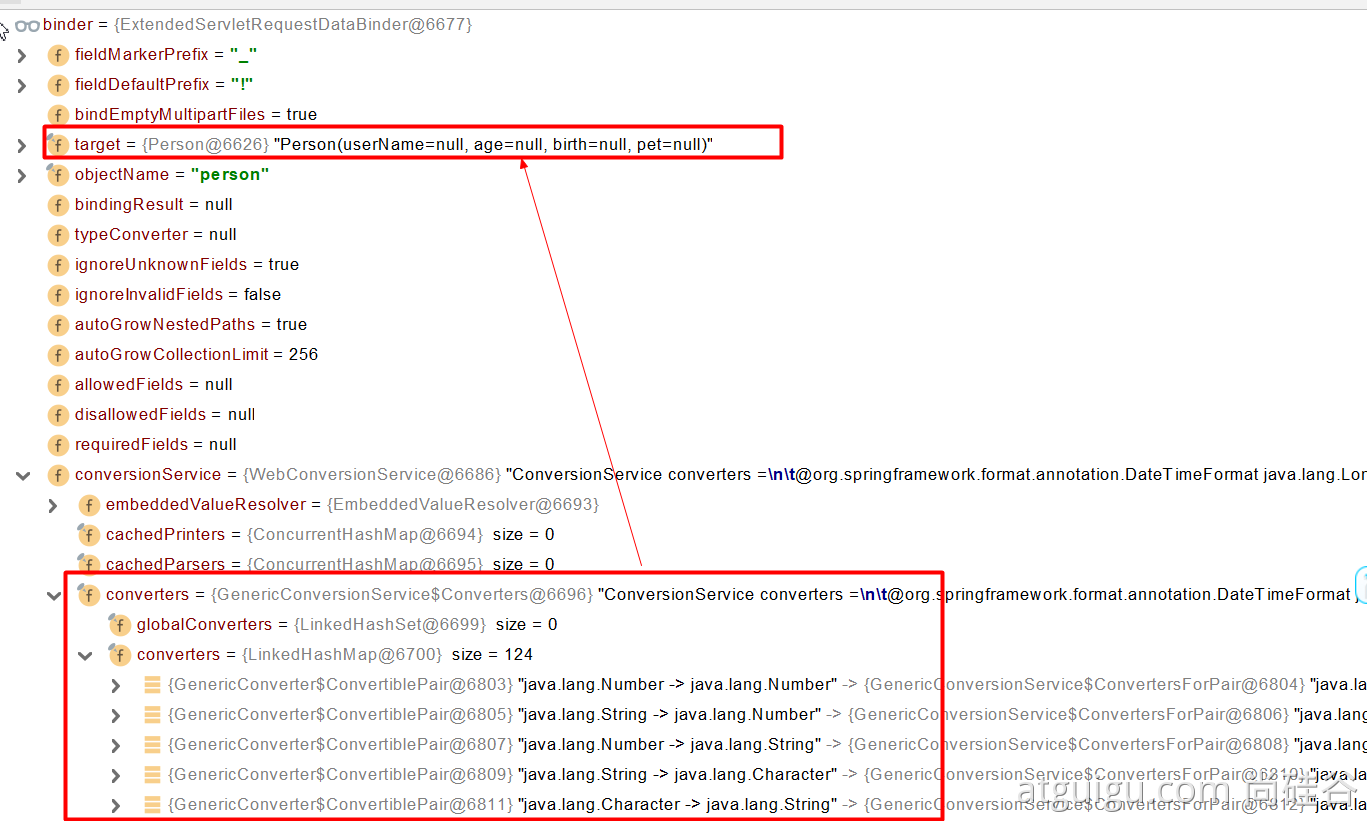
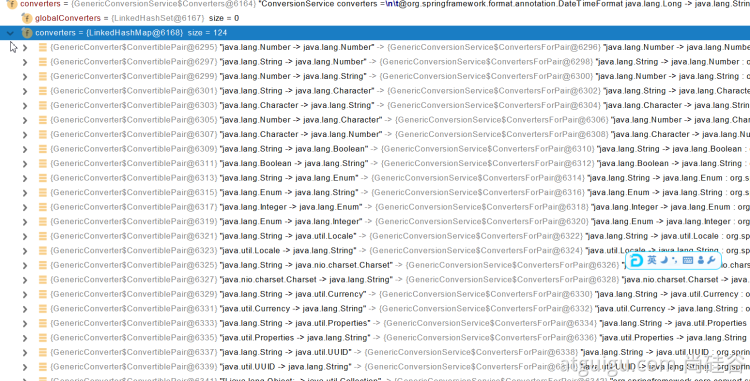
未来我们可以给WebDataBinder里面放自己的Converter;
private static final class StringToNumber<T extends Number> implements Converter<String, T>
自定义 Converter
//1、WebMvcConfigurer定制化SpringMVC的功能 @Bean public WebMvcConfigurer webMvcConfigurer(){ return new WebMvcConfigurer() { @Override public void configurePathMatch(PathMatchConfigurer configurer) { UrlPathHelper urlPathHelper = new UrlPathHelper(); // 不移除;后面的内容。矩阵变量功能就可以生效 urlPathHelper.setRemoveSemicolonContent(false); configurer.setUrlPathHelper(urlPathHelper); } @Override public void addFormatters(FormatterRegistry registry) { registry.addConverter(new Converter<String, Pet>() { @Override public Pet convert(String source) { // 啊猫,3 if(!StringUtils.isEmpty(source)){ Pet pet = new Pet(); String[] split = source.split(","); pet.setName(split[0]); pet.setAge(Integer.parseInt(split[1])); return pet; } return null; } }); } }; }
6、目标方法执行完成
将所有的数据都放在 ModelAndViewContainer;包含要去的页面地址View。还包含Model数据。
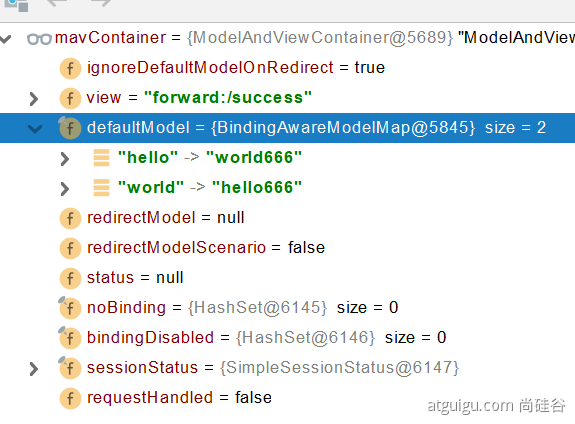
7、处理派发结果
processDispatchResult(processedRequest, response, mappedHandler, mv, dispatchException);
renderMergedOutputModel(mergedModel, getRequestToExpose(request), response);
InternalResourceView: @Override protected void renderMergedOutputModel( Map<String, Object> model, HttpServletRequest request, HttpServletResponse response) throws Exception { // Expose the model object as request attributes. exposeModelAsRequestAttributes(model, request); // Expose helpers as request attributes, if any. exposeHelpers(request); // Determine the path for the request dispatcher. String dispatcherPath = prepareForRendering(request, response); // Obtain a RequestDispatcher for the target resource (typically a JSP). RequestDispatcher rd = getRequestDispatcher(request, dispatcherPath); if (rd == null) { throw new ServletException("Could not get RequestDispatcher for [" + getUrl() + "]: Check that the corresponding file exists within your web application archive!"); } // If already included or response already committed, perform include, else forward. if (useInclude(request, response)) { response.setContentType(getContentType()); if (logger.isDebugEnabled()) { logger.debug("Including [" + getUrl() + "]"); } rd.include(request, response); } else { // Note: The forwarded resource is supposed to determine the content type itself. if (logger.isDebugEnabled()) { logger.debug("Forwarding to [" + getUrl() + "]"); } rd.forward(request, response); } }
暴露模型作为请求域属性 // Expose the model object as request attributes. exposeModelAsRequestAttributes(model, request);
protected void exposeModelAsRequestAttributes(Map<String, Object> model, HttpServletRequest request) throws Exception { //model中的所有数据遍历挨个放在请求域中 model.forEach((name, value) -> { if (value != null) { request.setAttribute(name, value); } else { request.removeAttribute(name); } }); }
